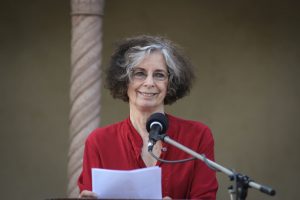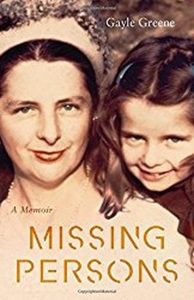The Tape on the Cutting Room Floor
 I never intended to write a memoir. I didn’t even like memoirs—novels have been my drug of choice since I was a kid, and my trade, as well, as a professor of literature. I was a bit of a snob about memoirs, to tell the truth. I’d read reviews and think, oh no, not another “how I survived my life” story.
I never intended to write a memoir. I didn’t even like memoirs—novels have been my drug of choice since I was a kid, and my trade, as well, as a professor of literature. I was a bit of a snob about memoirs, to tell the truth. I’d read reviews and think, oh no, not another “how I survived my life” story.
But when my mother and aunt died—first my aunt, sudden and unexpected, then my mother, drawn out and anguished— the loss was so excruciating, I found myself writing. Writing, between the crying jags, writing because even the best of friends gets tired of hearing you go on, writing because I had no other thing to do, none of the consolations people usually turn to at a time like this, no faith, no family—I was the end of our line.
A career woman with no children but many unresolved issues about my mother, with no chance to tell her now the things I wish I’d said, writing became my drug of choice.
That was when I began to read memoirs. I signed on to teach a course in memoirs, I, who had never read one. The memoirs I was drawn to were not sensational stories, not the “I was a sex slave,” “I was a woman trapped in a man’s body” sort of thing. No. I wanted to know, simply, how do people get through pain like this? I think there’s a special sting when you’re the last of a family and there’s nobody left who cares about the people you have lost; and when you’re in your fifties, there aren’t a lot of fun stories about new beginnings you can tell yourself. Also, nobody warns you how, when you’re in the grip of grief, you’re half out of your head, slightly crazed, and you don’t even know it, and what a wrecking job that can do on your life.
I was looking for stories like mine, closer to home, about the ordinary stuff of loss— what to do with the ashes, how to make a memorial, and the things, so many things. My mother’s house was a husk filled with things. The garage was loaded to the rafters, there were things piled on the rafters, too. And the photographs, photos in closets, cabinets, under beds, in an attic I didn’t even know we had. Achingly beautiful photos of a family and a California that were no more. But I never found a story like ours. I realized if I was going to get through this, I was going to have to make it up on my own, wing it, find some way of mourning unscripted by books or belief systems of the past.
And I discovered, to my surprise, that even the tasks that seemed most onerous were strangely soothing: clearing out the house, having a garage sale turned out to be steps in the letting go. Yes, and organizing the photos. What for? gnawed a voice, who cares—but I began to feel that sorting out their pasts, I was sorting out myself. And I found there were things I’d built in my life that sustained me now: friendships, teaching, a relationship. I didn’t need to travel to new lands to find a guru, find a new man; the one I had turned out to be gold. And writing, always a mainstay, sustained me too.
But I’d never written anything like this. I only knew there was this overwhelming grief that had to find a way out— and it was finding its way out, amazingly, through my fingers on the keys. There’d be days when my fingers seemed to have a life all their own.
There was so much wanting to get said, about how special they were, my mother and aunt, spunky, original women, yet stymied; the 1950s had no place for women like them. And my mother, beautiful, intelligent, unhappy, and oh so complicated— she could be a black hole in her depression, she could be the buoyancy I counted on when I was down. And my father, complicated, too, he broke her heart yet was highly principled in his medical practice, showed me the value of work—and I realized no one and nothing is ever one thing, the infinite complexity of human beings, even those we think we know best are mysteries.
My brother, I thought I knew him, I knew him least of all, how hard he was to write about— you don’t ever lay a suicide to rest. And the dogs, always the dogs, and the valley, “the valley of heart’s delight,” now no longer a paradise of orchards and fields of flowers, but a gridwork of highways, strip malls, high tech, Silicon Valley. All this came pouring out.
I gave no thought to the things people tell you to think about when you begin a book: “who’s your audience?” “what’s your elevator speech?”
I knew I’d have to shape it, of course—but how? how could I possibly find a shape, when it was my whole life, the whole of our lives and times together? I’d written books, but they were academic, more analytical than imaginative. It helped to be teaching all this while, to be dealing with students’ writing, working it out, working it through, finding the shape that made the sentence, the paragraph, the chapter, come clear. Me, too, I was writing it wrong, then writing it better, shaping it till it came ever so slowly clearer, clear. Lots of tape on the cutting room floor.
It was a process of discovery, only I wasn’t sure, for the longest time, what I was trying to discover. I was feeling longings I can only describe as spiritual, but I had no idea where to go with these—I’m not a believer—and this became something else that needed working through, finding someplace these longings could go. And I realized that this was the kind of memoir I liked best, that my students also liked best, the kind that gives a sense of working through, where things aren’t neatly sewn up, The Autobiography of a Face, This Boy’s Life. And I learned that this is something memoirs have over novels: they can be truer to the processes of discovery, don’t need a plot, an ending, that wraps it all up.
I still don’t have an elevator speech, but I see now that somewhere in the years it took me to sift through events and find a shape for Missing Persons, somehow, the overpowering grief gave way to love.
It’s still very hard to say exactly what this book “says.” It’s a mourning book, a long goodbye, but it’s also a celebration of our lives together, lives we rushed through on our way to somewhere else, not appreciating that life was then and there, not in some imagined future. Maybe that’s always the way it is, as that Joni Mitchell song says, don’t know what you’ve got till it’s gone, they paved paradise, put up a parking lot.
I’m not sure I ever really did get my mother in focus, but I came to a clearer sense of what I’d had lost, losing her, and my aunt, and even my womanizing father and despondent brother; their love for me and mine for them came through. I think their belief in me gave me the confidence to find in myself this kind of writing I never knew was there.
Works in progress we are, all of us.
https://www.facebook.com/gayle.greene.526
—
Gayle Greene is Professor Emerita at Scripps College. She began her writing life with books about Shakespeare, women writers, and feminist theory. Her interests then shifted to health and the environment, and she wrote a biography of anti-nuclear guru Alice Stewart, The Woman Who Knew Too Much: Alice Stewart and the Secrets of Radiation, and a sort of a memoir, Insomniac, a first-person account of living with insomnia and an investigation into sleep science. Her most recent book is Missing Persons: A Memoir.
https://www.facebook.com/gayle.greene.526
About MISSING PERSONS
 Missing Persons is a memoir about dealing with death in a culture that gives no help. As the last of her family, Greene’s losses are stark, first her aunt, then her mother, in quick succession. She is as ill-equipped for the challenges of caring for a dying person at home as she is for the other losses, long repressed, that rise to confront her at this time: the suicide of her younger brother, the death of her father. As the professional identity on which she’s based her selfhood comes to feel brittle and trivial, she is catapulted into questions of “who am I?” and “what have I done with my life?”
Missing Persons is a memoir about dealing with death in a culture that gives no help. As the last of her family, Greene’s losses are stark, first her aunt, then her mother, in quick succession. She is as ill-equipped for the challenges of caring for a dying person at home as she is for the other losses, long repressed, that rise to confront her at this time: the suicide of her younger brother, the death of her father. As the professional identity on which she’s based her selfhood comes to feel brittle and trivial, she is catapulted into questions of “who am I?” and “what have I done with my life?”
The memoir is structured as an account of her mother’s and aunt’s final days and the year that follows, a year in which she reconstructs her life. This is a powerful story about family, what it means to have one, to lose one, never to have made one, and what, if anything, might take its place. It’s the story of a vexed mother-daughter relationship that mellows with age. It is also a search for home, as the very landscape shifts around her and the vast orchards are dug up and paved over for tract housing, strip malls, freeways, and the Santa Clara Valley, once known as the Valley of Heart’s Delight, is transformed to “Silicon.”
Category: On Writing























